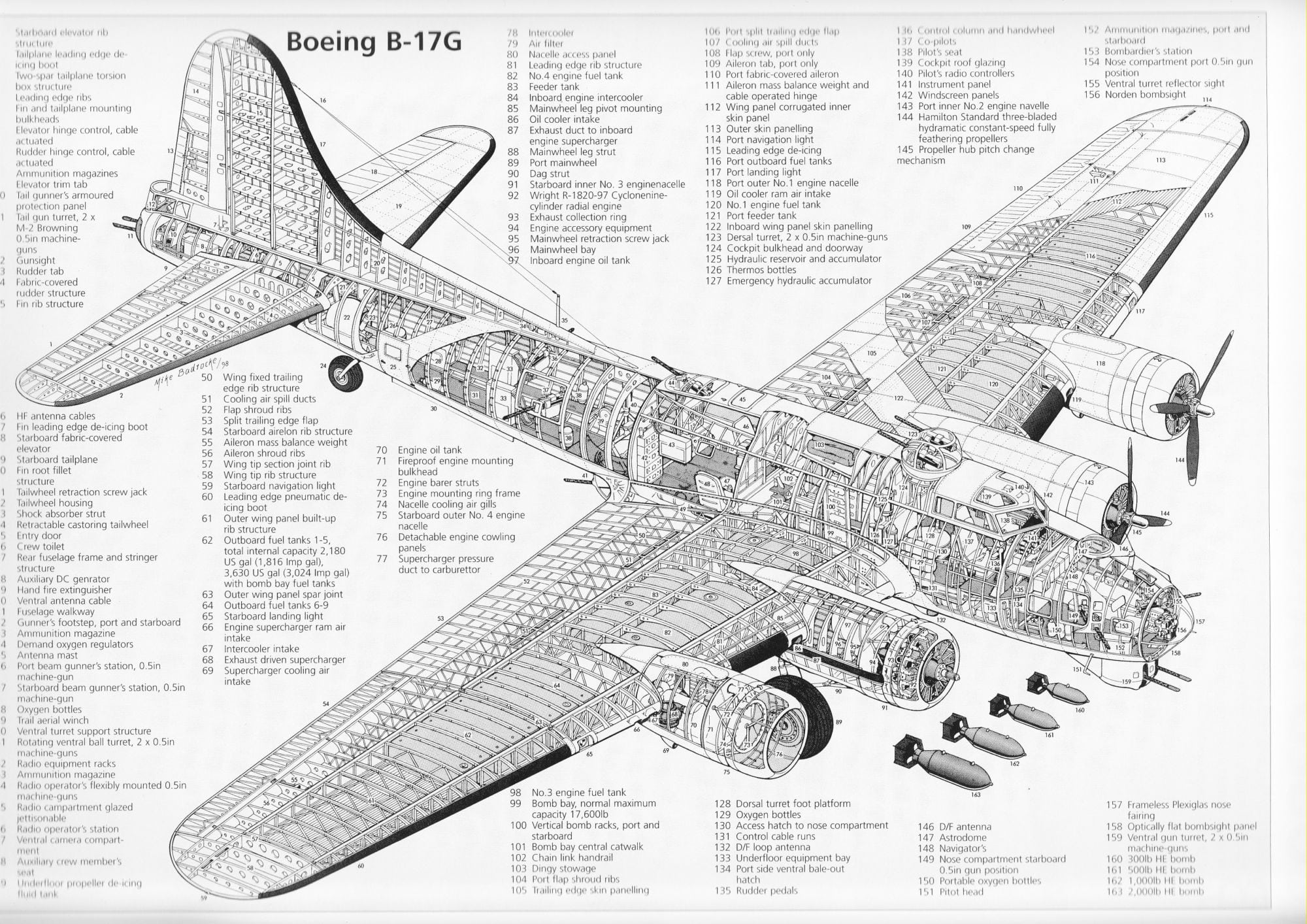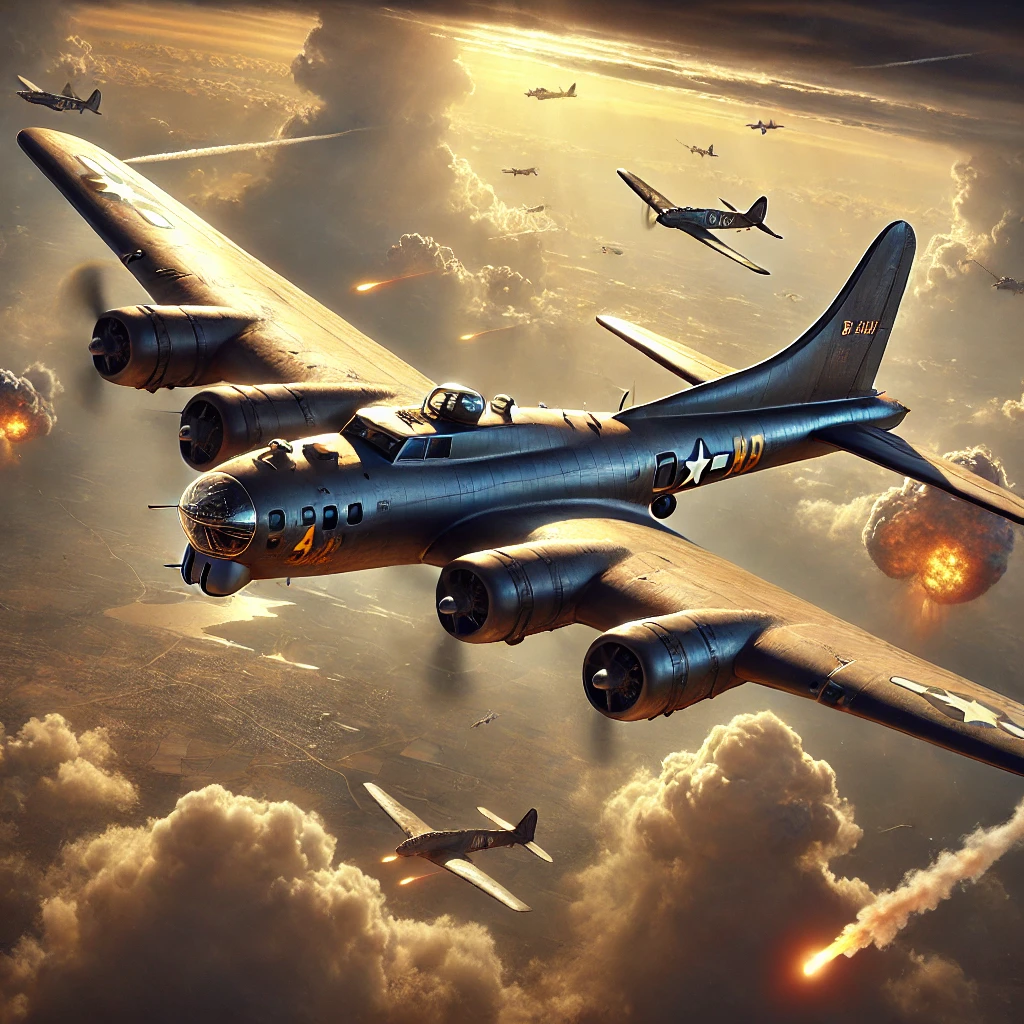The "flying fortresses" of World War II are among the most iconic symbols of the conflict, embodying the power and technological innovation of the time. Among these aerial giants, the Boeing B-17 Flying Fortress stands out for its crucial role in the Allied strategic bombing operations.
Construction and Details
The B-17 was designed by Boeing in the 1930s in response to a request from the United States Army Air Corps for a medium bomber capable of operating over long distances. Its robust structure and large payload capacity made it ideal for long-range missions. The innovative design included four Wright R-1820 Cyclone radial engines, ensuring power and reliability. The aluminum fuselage and low-wing design provided greater stability and resistance to combat damage.
Technical Specifications
The B-17 had a wingspan of 31.6 meters and a length of 22.7 meters. It could reach a maximum speed of about 462 km/h and had a flight range of over 3,200 kilometers. Its defensive armament included up to 13 Browning M2 .50 caliber machine guns, positioned in various turrets to provide 360-degree coverage against enemy fighters. The bomb load capacity varied, but it could carry up to 8,000 pounds (approximately 3,600 kg) of bombs.

Boeing B-17 Flying Fortress Cutaway - Aeronauticsmagazine.com
Roles and Combat Scenarios
The B-17 played a key role in the European theater of war, participating in strategic bombing missions against German industrial and military targets. Its ability to fly at high altitudes and the robustness of its structure allowed it to withstand significant combat damage, increasing the chances of mission completion and safe return to base. Formations of B-17s, often escorted by fighters like the P-51 Mustang, faced intense anti-aircraft defenses and attacks from the Luftwaffe, significantly contributing to weakening the German war apparatus.

bombadier navigator compartment Veteransbreakfastclub.org
The Influence of Flying Fortresses in Hayao Miyazaki’s Works
The imagery of World War II flying fortresses has profoundly influenced the work of Hayao Miyazaki, the master of Japanese animation. His passion for flight and aerial machines is reflected in numerous films, where inspiration from military aircraft of the era is evident.
Miyazaki’s fascination with aviation has deep roots in his biography. His father, Katsuji Miyazaki, was an administrator at Miyazaki Airplane, a company that produced components for Japanese fighter planes, such as the Zero, during the war. This family background fueled young Hayao’s passion for aviation, influencing his future artistic productions.
In Laputa: Castle in the Sky (1986), for instance, there are airships and flying machines that, while belonging to a fantasy world, resemble the shapes and functionalities of World War II bombers. The flying fortresses responsible for the planet’s destruction even share a name with the B-29 Superfortress, the bomber that dropped atomic bombs on Japanese cities.
In Howl’s Moving Castle (2004), the setting includes elements reminiscent of early 20th-century Europe, with military conflicts fought using flying war machines. These flying contraptions, though fantastical, exhibit stylistic influences directly linked to the military aircraft of the time.
The depiction of flight in Miyazaki’s films goes beyond technical aspects, taking on a poetic and symbolic dimension, representing freedom, adventure, and the pursuit of the unknown. This passion for aviation is a constant theme in his filmography, helping create fascinating and intricately detailed imaginary worlds.
Cinematic Legacy and Collective Imagination
The B-17 has left an indelible mark on the collective imagination, becoming the subject of numerous films and documentaries. Movies like Memphis Belle (1990) have told the stories of the crews of these flying fortresses, highlighting the courage and determination of young aviators. The portrayal of the B-17 in cinema has helped cement its image as a symbol of resilience and strength, fueling fascination with World War II aviation.
Today, the B-17 is celebrated not only as a marvel of aeronautical engineering but also as a representation of the fighting spirit of the Allies. The few remaining operational units participate in air shows and are exhibited in museums, keeping the memory alive of an era when air superiority was crucial for victory.
References
Boeing B-17 Flying Fortress - Wikipedia: en.wikipedia.org
Hayao Miyazaki - Wikipedia: en.wikipedia.org
Laputa: Castle in the Sky - Wikipedia: en.wikipedia.org
Howl’s Moving Castle - Wikipedia: en.wikipedia.org
Hayao Miyazaki's Airships - YouTube:








Leave a Comment